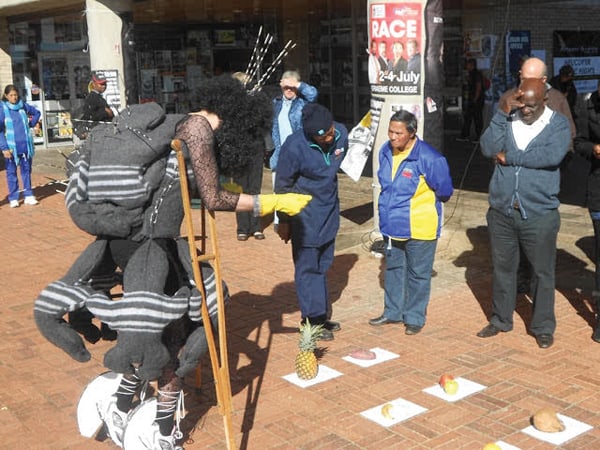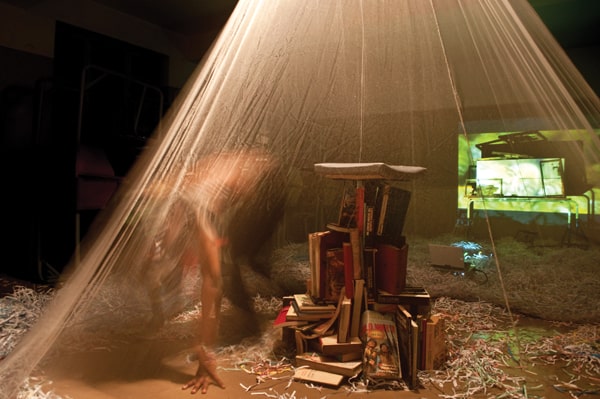FRUIT SALAD
RETURNING TO CAPE TOWN AFTER A SIX-YEAR ABSENCE, YOUNG PERFORMANCE ARTIST AND CHOREOGRAPHER GAVIN KRASTIN SPOKE TO GENNA GARDINI ABOUT ART, FRUIT AND HOMECOMINGS.


 top – bottom Gavin Krastin, Lady Exhibiting Satirical Fruit Salad, 2012,
top – bottom Gavin Krastin, Lady Exhibiting Satirical Fruit Salad, 2012,‘Project 200: The Misses/Missus Series’, performance, National Arts
Festival; Gavin Krastin, sub-, 2011, performance. Photo: Dianne Jordan;
Gavin Krastin, The Pied Piper Pipe Bomber, 2012, ‘Project 200:
The Misses/Missus Series’, performance. Photo: Alan Parker.
At the 2012 National Arts Festival (NAF), visitors to Grahamstown’s 1820 Settlers National Monument were met with what might be described as a simultaneously ordinary and unusual sight: various types of fruit (including one pineapple) painstakingly titled, priced and laid out on the pavement just outside the main entrance of the building. It’s not uncommon to see hawkers selling similar wares outside venues at the NAF but it is a change to view those goods curated as if inside a gallery space. ‘I carefully exhibited the fruit to sell at exorbitant prices, as if they were expensive hoi-polloi pieces of art,’ laughs Krastin. ‘At festival time, the distinction between high art and craft, between buskers and theatre, and the spaces they inhabit and why, becomes very evident.’
Titled Lady Exhibiting Satirical Fruit Salad, the installation formed part of Krastin’s larger ‘Project 200: The Misses/Missus Series’, three public performance interventions staged in and around Grahamstown. Krastin, who placed the fruit in front of bystanders while dressed as a sort of vendor-arachnid, wanted to ‘question what we regard as art and what as craft, what is public performance and what is the difference? I also wanted to demonstrate that this depends on who you are and where you have the luxury of exhibiting your work.’ Lady, created to ‘uncelebrate’ Grahamstown’s bicentennial anniversary (‘How do you celebrate and commemorate land that was founded on bloodshed and hatred?’ he asks), won the young artist Standard Bank Aha Award at the 2012 National Art Festival Encore Awards ceremony although, perhaps, not the approval of the bicentennial anniversary organising committee. This is not the first time that Krastin has produced work that has garnered acclaim from some while perplexing others. Sub-, the 2011 performance piece he presented at the NAF as part of his MA in Choreography, was held at Nombulelo Secondary School, outside of the relatively privileged confines of central Grahamstown. Audience members were bussed in at night and instructed to roam the school within the allocated fifty minutes or risk being left there. Krastin choreographed and designed a series of performances and installations across the school, which viewers had to actively search out in the limited timeframe. ‘What resulted was that the audience members could never conceive of the piece as a complete whole,’ says Krastin. Those fleeting glimpses into classrooms, staffrooms, bathrooms and courtyards being performed in infuriated some who demanded more time or a more structured route through the piece but intrigued others (Krastin won a Standard Bank Encore Ovation award for the work). Somewhat fuelled by the success of sub-, Krastin collaborated with then First Physical Theatre company resident choreographer Alan Parker and digital artist Rat Western in 2012 to produce DISCHARGE, a huge post-apocalyptic performance piece located in a hangar of the First City Regiment Military Base and commissioned for the NAF’s newly formalised Performance Art Main programme. Krastin, in performance mode, comes across as the love child of Steven Cohen and Lady Gaga, all teetering Golgotha heels and outfits constructed out of perishables. The Cape Town-born-and-raised artist’s interest in designing both the movement and the aesthetic of the performing body was clear when he arrived at Rhodes University in 2006. After some initial uncertainty around whether to major in fine art or drama, he eventually chose the latter and, in 2011, graduated with an MA in Choreography. ‘Body-based art excites me more than object making,’ he explains. ‘I relish the immediacy and presence of the moving, breathing, sweaty body. For me, the body is a host of an infinity of transformations and endless potentials, unearthing the poetics and politics of space and how one occupies it.’
This notion of choreographing the body as well as the space it performs in is integral to Krastin’s work: ‘Before even considering the movement language, I investigate what I want the space and bodies to look like and what the objects and properties they engage with speak,’ he says. His design-heavy style of choreography has its detractors: ‘I am aware that this approach irks some people, as a deep interrogation of dance vocabularies is not always my chief aim,’ he admits. ‘We have been led to believe that as a choreographer (or someone who has that label attached to them), it should be.’ Krastin, despite his MA in Choreography, often bucks against that title. He describes his work as ‘slightly non-traditional choreographer-type or dancey’. However, what he may lack or avoid in terms of a ‘dancey’ choreographic language is often provided by his long-time collaborator and partner, Parker. ‘Alan’s strengths are my weaknesses and vice versa,’ explains Krastin. ‘Unlike me, Alan’s primary concern in choreographing is often the dance language and the movement in space. I, on the other hand, approach a work with the aesthetic qualities of the body and space as a principal concern, attempting to view space with its conceptual underpinnings in mind.’
At the end of 2012, after a year of lecturing in the Rhodes drama department, Krastin returned to Cape Town. ‘Moving back has been great but difficult,’ he says. ‘At the moment I’m looking for some sort of sustainable job in the industry, one that will still allow for and support my personal projects and freelance career – this is proving to be elusive.’ Krastin seems to want to use the time and space provided by the move to consider ideas around archiving performance art. ‘So often these sweeping public interventions are like a fart in the wind, and yes, that is also the magic of intervention art, but I want to try and contain it and accumulate it as to present a curated exhibition of a body of work,’ he says. ‘So this idea of an interdisciplinary and ephemeral time-based arts curatorship and archiving is something that I wish to explore and pursue further.’
Genna Gardini is a Cape Town-based writer studying towards an MA in Theatre Making (Playwriting) at UCT.
First published in Art South Africa Volume 11: Issue 03



